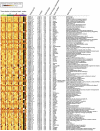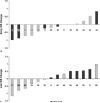Periodontal therapy alters gene expression of peripheral blood monocytes
- PMID: 17716309
- PMCID: PMC2670555
- DOI: 10.1111/j.1600-051X.2007.01113.x
Periodontal therapy alters gene expression of peripheral blood monocytes
Abstract
Aims: We investigated the effects of periodontal therapy on gene expression of peripheral blood monocytes.
Methods: Fifteen patients with periodontitis gave blood samples at four time points: 1 week before periodontal treatment (#1), at treatment initiation (baseline, #2), 6-week (#3) and 10-week post-baseline (#4). At baseline and 10 weeks, periodontal status was recorded and subgingival plaque samples were obtained. Periodontal therapy (periodontal surgery and extractions without adjunctive antibiotics) was completed within 6 weeks. At each time point, serum concentrations of 19 biomarkers were determined. Peripheral blood monocytes were purified, RNA was extracted, reverse-transcribed, labelled and hybridized with AffymetrixU133Plus2.0 chips. Expression profiles were analysed using linear random-effects models. Further analysis of gene ontology terms summarized the expression patterns into biologically relevant categories. Differential expression of selected genes was confirmed by real-time reverse transcriptase-polymerase chain reaction in a subset of patients.
Results: Treatment resulted in a substantial improvement in clinical periodontal status and reduction in the levels of several periodontal pathogens. Expression profiling over time revealed more than 11,000 probe sets differentially expressed at a false discovery rate of <0.05. Approximately 1/3 of the patients showed substantial changes in expression in genes relevant to innate immunity, apoptosis and cell signalling.
Conclusions: The data suggest that periodontal therapy may alter monocytic gene expression in a manner consistent with a systemic anti-inflammatory effect.
Figures





References
-
- Behle JH, Papapanou PN. Periodontal infections and atherosclerotic vascular disease: an update. International Dental Journal. 2006;56:256–262. - PubMed
-
- Bjorkbacka H. Multiple roles of Toll-like receptor signaling in atherosclerosis. Current Opinion in Lipidology. 2006;17:527–533. - PubMed
-
- D'Aiuto F, Nibali L, Parkar M, Suvan J, Tonetti MS. Short-term effects of intensive periodontal therapy on serum inflammatory markers and cholesterol. Journal of Dental Research. 2005;84:269–273. - PubMed
-
- D'Aiuto F, Parkar M, Andreou G, Suvan J, Brett PM, Ready D, Tonetti MS. Periodontitis and systemic inflammation: control of the local infection is associated with areduction in serum inflammatory markers. Journal of Dental Research. 2004a;83:156–160. - PubMed
-
- D'Aiuto F, Parkar M, Nibali L, Suvan J, Lessem J, Tonetti MS. Periodontal infections cause changes in traditional and novel cardiovascular risk factors: results from a randomized controlled clinical trial. American Heart Journal. 2006;151:977–984. - PubMed
Publication types
MeSH terms
Substances
Grants and funding
LinkOut - more resources
Full Text Sources
Other Literature Sources
Molecular Biology Databases

